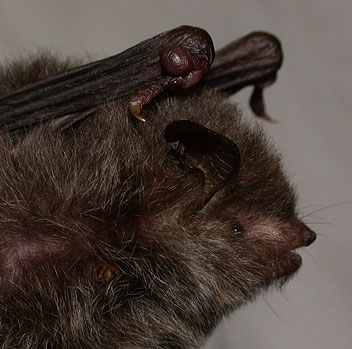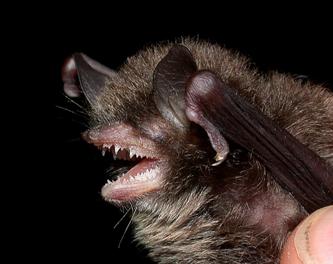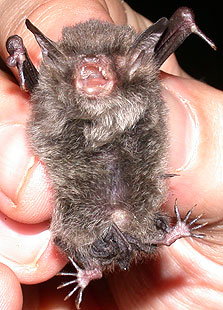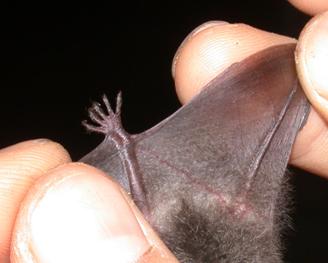Myotis siligorensis
Himalayan Whiskered Bat
Morphological description Life history Distribution Habitat Roost sites and roosting patterns Emergence and flight pattern Foraging behaviour Echolocation calls Status and protection




Morphological Description
· Dorsal fur is black-brown. Ventral fur is grey-brown (tips) and dark brown (roots).
· Juveniles are lighter than adults.
· This is a small bat in China. Forearm length is between 30.0-31.5 mm (Medway 1969). measurements of 3 Chinese bats 33.1-35.2 mm, body mass 3.0-4.6 g.
· The muzzle is pointed with a well developed fringe of hairs on the upper lip (Bates & Harrison 1997).
· The karyotype was investigated by Harada et al. (1985): 2n=44, FN=56 (female), 55 (male).
· Attachment of wing membrane to base of phalanx of outer metatarsal shown in photos above. Dentition reduced.
Life history
· Little known
Distribution
The mainland Chinese distribution is shown by dots on the map (as given by Zhang et al. (1997) and Wang (2003)). We have captured this species in Guangxi, Guangdong and Yunnan Provinces.

Habitat
· Fed in a valley below a cave roost in Thailand, with a reservoir at one end. The valley included a sugar cane field and secondary forest growth.
Roost sites and roosting behaviour
· This myotis uses crevices in roofs as diurnal roosts (Bates & Harrison 1997).
· This species may share roosts with other bat species. Roosted in a cave at least during the night in Guangxi, and uses cave roosts in Thailand (Surlykke et al. 1993)
Emergence and flight pattern
· Emerged just after sunset and hunted at least until 02.00h in Thailand (Surlykke et al. 1993).
· Flew 2-5 m above the ground, and flew at 4.1-4.9 m/s (Surlykke et al. 1993).
Foraging behaviour
· In Thailand bats foraged in open areas, and moved between foraging sites (Surlykke et al. 1993).
Echolocation calls
· Unusually for a myotis, this species emits calls that sweep down rapidly to a narrowband tail. The frequency of most energy in this tail is at 78-80 kHz, considerably higher in frequency than recorded in Thailand, where the tail is at 66 kHz (Surlykke et al. 1993). It is therefore possible that the Chinese and Thai bats represent cryptic species.
Status and protection
· There is no estimation of population size for China.
· Himalayan whiskered bats are at LR/lc, assessed by the Red List of Threatened Species (IUCN, 2007) and are not listed in the Law of the People's Republic of China on the Protection of Wildlife in 1989.
· Caves and surroundings should be protected as their habitats.